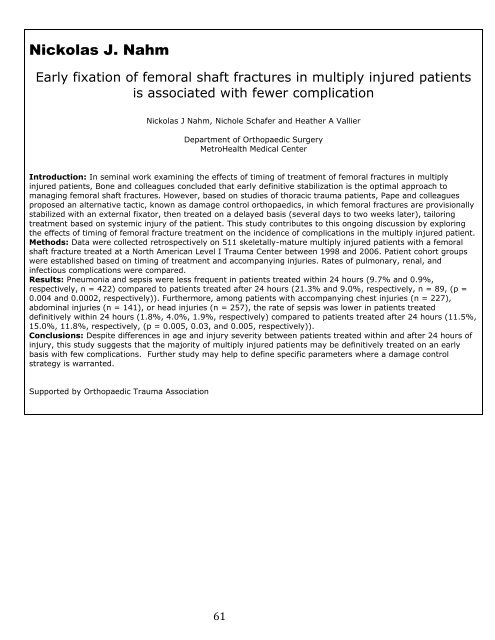student research day - Case Western Reserve University School of ...
student research day - Case Western Reserve University School of ...
student research day - Case Western Reserve University School of ...
You also want an ePaper? Increase the reach of your titles
YUMPU automatically turns print PDFs into web optimized ePapers that Google loves.
Nickolas J. Nahm<br />
Early fixation <strong>of</strong> femoral shaft fractures in multiply injured patients<br />
is associated with fewer complication<br />
Nickolas J Nahm, Nichole Schafer and Heather A Vallier<br />
Department <strong>of</strong> Orthopaedic Surgery<br />
MetroHealth Medical Center<br />
Introduction: In seminal work examining the effects <strong>of</strong> timing <strong>of</strong> treatment <strong>of</strong> femoral fractures in multiply<br />
injured patients, Bone and colleagues concluded that early definitive stabilization is the optimal approach to<br />
managing femoral shaft fractures. However, based on studies <strong>of</strong> thoracic trauma patients, Pape and colleagues<br />
proposed an alternative tactic, known as damage control orthopaedics, in which femoral fractures are provisionally<br />
stabilized with an external fixator, then treated on a delayed basis (several <strong>day</strong>s to two weeks later), tailoring<br />
treatment based on systemic injury <strong>of</strong> the patient. This study contributes to this ongoing discussion by exploring<br />
the effects <strong>of</strong> timing <strong>of</strong> femoral fracture treatment on the incidence <strong>of</strong> complications in the multiply injured patient.<br />
Methods: Data were collected retrospectively on 511 skeletally-mature multiply injured patients with a femoral<br />
shaft fracture treated at a North American Level I Trauma Center between 1998 and 2006. Patient cohort groups<br />
were established based on timing <strong>of</strong> treatment and accompanying injuries. Rates <strong>of</strong> pulmonary, renal, and<br />
infectious complications were compared.<br />
Results: Pneumonia and sepsis were less frequent in patients treated within 24 hours (9.7% and 0.9%,<br />
respectively, n = 422) compared to patients treated after 24 hours (21.3% and 9.0%, respectively, n = 89, (p =<br />
0.004 and 0.0002, respectively)). Furthermore, among patients with accompanying chest injuries (n = 227),<br />
abdominal injuries (n = 141), or head injuries (n = 257), the rate <strong>of</strong> sepsis was lower in patients treated<br />
definitively within 24 hours (1.8%, 4.0%, 1.9%, respectively) compared to patients treated after 24 hours (11.5%,<br />
15.0%, 11.8%, respectively, (p = 0.005, 0.03, and 0.005, respectively)).<br />
Conclusions: Despite differences in age and injury severity between patients treated within and after 24 hours <strong>of</strong><br />
injury, this study suggests that the majority <strong>of</strong> multiply injured patients may be definitively treated on an early<br />
basis with few complications. Further study may help to define specific parameters where a damage control<br />
strategy is warranted.<br />
Supported by Orthopaedic Trauma Association<br />
61
















